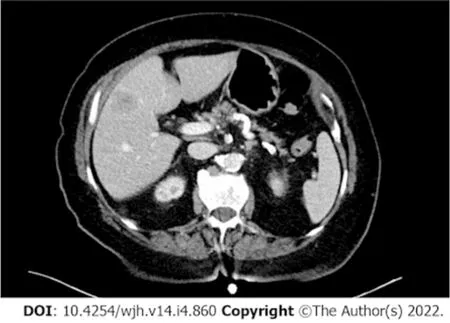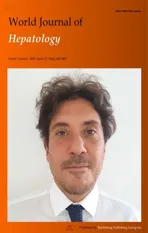Not all liver tumors are alike — an accidentally discovered primary hepatic leiomyosarcoma: A case report
2022-07-02IsabelGarridoPatrciaAndradeJoPachecoElisabeteRiosGuilhermeMacedo
Isabel Garrido, Patrícia Andrade, João Pacheco, Elisabete Rios, Guilherme Macedo
Isabel Garrido, Patrícia Andrade, Guilherme Macedo, Gastroenterology and Hepatology Department, Centro Hospitalar Universitário de São João, Porto 4200-319, Portugal
Isabel Garrido, Patrícia Andrade, Guilherme Macedo, World Gastroenterology Organization Porto Training Center, Porto 4200-319, Portugal
João Pacheco, Elisabete Rios, Pathology Department, Centro Hospitalar Universitário de São João, Porto 4200-319, Portugal
Abstract BACKGROUND Primary hepatic leiomyosarcoma is a very rare entity that originates from smooth muscle. Preoperative diagnosis requires a high degree of suspicion due to atypical clinical presentation and non-specific imaging features.CASE SUMMARY We report the case of a 42-year-old man, with no relevant past medical history, accidentally diagnosed with a nodular liver lesion on a routine abdominal ultrasound. Liver function tests and hematology parameters as well as tumor markers were normal. A contrast-enhanced abdominal computed tomography scan revealed a heterogenous hepatic lesion measuring 40 mm 30 mm, adjacent to the left branch of the portal vein and the round ligament. Due to the unclear diagnosis, the patient underwent surgical resection. Histopathological and immunohistochemical examinations confirmed complete (R0) resection of a hepatic leiomyosarcoma. The patient remains without any signs of tumor recurrence for more than 2 years.CONCLUSION We report a rare case of accidentally diagnosed primary hepatic leiomyosarcoma originating from the portal vein or the round ligament. Although this tumor has aggressive metastatic potential, a tumor-free resection margin is essential to improve survival.
Key Words: Primary hepatic leiomyosarcoma; Portal vein; Round ligament; Surgical resection; Case report
INTRODUCTION
Sarcomas comprise only 1%-2% of all primary liver malignancies, and leiomyosarcoma is even rarer[1]. In the vast majority of cases of primary hepatic leiomyosarcoma, the tumor originates in the inferior vena cava. Clinical presentation and imaging features are non-specific and can mimic the most frequent primary liver tumors, namely hepatocellular carcinoma and intrahepatic cholangiocarcinoma. This tumor has aggressive metastatic potential and is usually diagnosed in a locally advanced or metastatic disease[2]. We report a rare case of primary hepatic leiomyosarcoma originating from the portal vein or the round ligament, accidentally diagnosed and surgically treated.
CASE PRESENTATION
Chief complaints
The patient was asymptomatic.
History of present illness
A 42-year-old man was referred for gastroenterology consultation due to a nodular hepatic lesion identified in a routine abdominal ultrasound.
History of past illness
Healthy, with no specific diseases.
Personal and family history
There was no family history of liver disease.
Physical examination
There were no relevant changes on physical examination.
Laboratory examinations
Liver tests were normal. The metabolic, virological and autoimmune study was negative. Alphafetoprotein and cancer antigen 19-9 were also normal.
Imaging examinations
A contrast-enhanced abdominal computed tomography scan was performed, revealing a nodular hepatic lesion measuring 40 mm × 30 mm, adjacent to the left branch of the portal vein, in the transition from the right to the left lobe (Figure 1). The tumor was contrast-enhancing, with heterogeneous areas inside.

Figure 1 Preoperative contrast-enhanced computed tomography scan demonstrated a heterogeneous mass in the liver adjacent to the left branch of the portal vein.
MULTIDISCIPLINARY EXPERT CONSULTATION
The imaging characteristics did not allow for a categorical distinction between hydatid cyst or other etiology. Therefore, it was decided at the multidisciplinary team meeting to perform surgical resection.
TREATMENT
In the explored laparoscopy, an exophytic lesion in segment IV was identified, involving the left branch of the portal vein and the round ligament; non-anatomic resection was performed without complications.
FINAL DIAGNOSIS
Histological examination showed complete resection of malignant mesenchymal neoplasia consisting of spindle cells with nuclei elongated to ovoid, with atypia and marked pleomorphism (Figure 2). In the immunohistochemical study, diffuse expression of actin and desmin was observed in neoplastic cells, in the absence of S100 expression. A chest-abdomen-pelvis computed tomography scan was performed in the postoperative period, with no evidence of residual or metastatic lesions. Moreover, this examination made it clear that it was a primary lesion. Thus, primary hepatic leiomyosarcoma was diagnosed with origin in the portal vein wall or the round ligament.

Figure 2 Hepatic leiomyosarcoma. A: A well-circumscribed, white, solid mass of 4.3 cm exhibiting whorled features was seen on gross examination. B: Histologically, intersecting fascicles of spindle cells with elongate to ovoid nuclei displaying marked pleomorphism were observed [hematoxylin & eosin (HE), 40 ×]. C: Mitotic figures, including atypical ones, were frequent (7 mitosis/10 high power field) (HE, 200 ×). D: Foci of coagulative necrosis were observed (HE, 40 ×). E and F: Tumor cells were diffusely positive for desmin (100 ×) (E) and smooth muscle actin (100 ×) (F), in the absence of S100, c-Kit and discovered on GIST-1 (not shown).
OUTCOME AND FOLLOW-UP
The patient remained under clinical surveillance. Two years after surgery, he is asymptomatic, with no evidence of tumor recurrence.
DISCUSSION
Primary hepatic leiomyosarcoma is a rare type of liver sarcoma; so far, less than 100 cases have been reported in the literature. Its diagnosis requires a high level of suspicion because the clinical scenario and cross-imaging are not specific[3]. In fact, patients are often asymptomatic or their symptoms are non-specific. Furthermore, alpha-fetoprotein and other serological markers are usually normal. Thus, histological examination is the only way to achieve the diagnosis, as in our case.
Primary hepatic leiomyosarcoma can arise from intrahepatic vascular structures, bile ducts or the round ligament. In our case, the tumor probably originated from the left branch of the portal vein or the round ligament. The first description of leiomyosarcoma by Perl in 1871 involved a tumor of the inferior vena cava[4]. Indeed, leiomyosarcoma of vascular origin often occurs in the inferior vena cava. On the other hand, those arising from portal vein are extremely rare and only 6 cases have been reported in the literature (Table 1)[5-10].

Table 1 Reported cases of leiomyosarcoma of the portal vein
No risk factors have been identified yet, although the increasing incidence of the tumor has been noted among immunosuppressed patients[11]. Nevertheless, more studies are needed to investigate the underlying pathogenetic mechanisms of this uncommon entity.
Due to the rarity of primary hepatic sarcomas in general and primary hepatic leiomyosarcoma in particular, the standard of care has not been defined. Radical R0 hepatectomy, in the form of wedge resection, segmentectomy, lobectomy or extended hepatectomy, is the cornerstone of successful management of primary hepatic leiomyosarcoma[12]. In our case, as the tumor was located in the liver, we were able to perform a surgical resection, obtaining a tumor-free margin. However, this tumor has aggressive metastatic potential and is usually diagnosed in locally advanced or metastatic disease. The role of adjuvant or neoadjuvant chemotherapy and radiotherapy regimens in these circumstances has not yet been established. Similarly, orthotopic liver transplantation remains controversial.
Little is known about the natural history of the disease. However, survival rates are relatively low, as the tumor is usually diagnosed in advanced stages. Chiet al[1] reported a median overall survival of 19 mo (range 0-181 mo) with 1-, 2- and 5-year survival rates of 61.2%, 41.1% and 14.5%, respectively. The smaller size of the lesion and tumor-free resection margin were identified as independent predictors of improved survival. Two years after surgical resection, our patient is alive and with no evidence of tumor recurrence, probably because the diagnosis was established at an early stage and the surgery achieved a tumor-free margin.
CONCLUSION
Primary hepatic leiomyosarcoma is a rare malignant disease with a poor prognosis. The authors report a rare case of resected primary hepatic leiomyosarcoma originating from the portal vein or the round ligament. Although there is no standard treatment due to the rarity of this disease, we showed that liver resection with a tumor-free resection margin could be an effective treatment in the early stages. Gastroenterologists should be alert to this unusual entity as early diagnosis requires a high degree of suspicion due to atypical clinical presentation and non-specific imaging features. We emphasize the need for a global database for these rare tumors to promote a better understanding and standardized treatment of these patients.
FOOTNOTES
Author contributions:Garrido I drafted the manuscript; Garrido I, Andrade P, Pacheco J, Rios E and Macedo G have revised and finalized the manuscript; All authors have approved the final version of the manuscript.
Informed consent statement:Written informed consent was obtained from the patient for publication of this case report and any accompanying images.
Conflict-of-interest statement:The authors have no disclosures to report.
CARE Checklist (2016) statement:The authors have read the CARE Checklist (2016), and the manuscript was prepared and revised according to the CARE Checklist (2016).
Open-Access:This article is an open-access article that was selected by an in-house editor and fully peer-reviewed by external reviewers. It is distributed in accordance with the Creative Commons Attribution NonCommercial (CC BYNC 4.0) license, which permits others to distribute, remix, adapt, build upon this work non-commercially, and license their derivative works on different terms, provided the original work is properly cited and the use is noncommercial. See: https://creativecommons.org/Licenses/by-nc/4.0/
Country/Territory of origin:Portugal
ORCID number:Isabel Garrido 0000-0002-7801-466X; Patrícia Andrade 0000-0003-1334-0947; João Pacheco 0000-0001-9348-1226; Elisabete Rios 0000-0002-3523-5032; Guilherme Macedo 0000-0002-9387-9872.
S-Editor:Gong ZM
L-Editor:Filipodia
P-Editor:Gong ZM
杂志排行
World Journal of Hepatology的其它文章
- Revolution in the diagnosis and management of hepatitis C virus infection in current era
- Evidence-based approach to management of hepatic encephalopathy in adults
- Direct oral anticoagulant administration in cirrhotic patients with portal vein thrombosis: What is the evidence?
- Noninvasive diagnosis of periportal fibrosis in schistosomiasis mansoni: A comprehensive review
- Review on hepatitis B virus precore/core promoter mutations and their correlation with genotypes and liver disease severity
- Assessment of periportal fibrosis in Schistosomiasis mansoni patients by proton nuclear magnetic resonance-based metabonomics models
